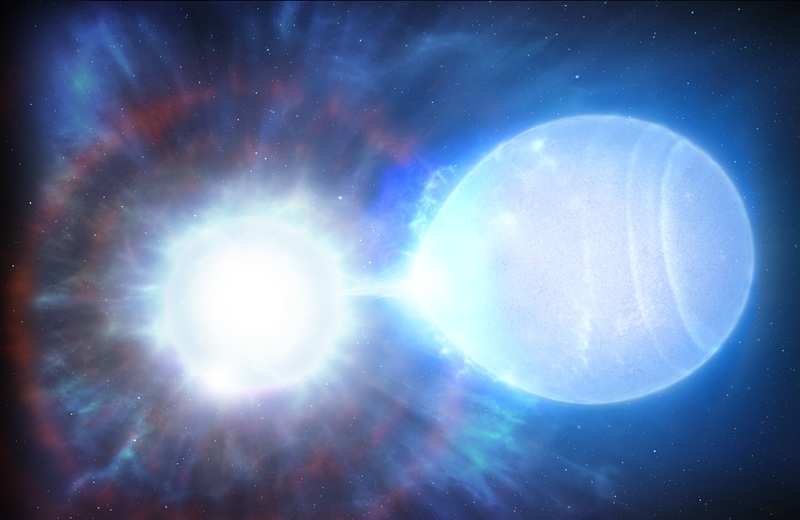A small international team of astronomers including Silvia Toonen (UvA) and Gijs Nelemans (RU, KU Leuven and SRON) has discovered two white dwarf stars orbiting each other that will merge and explode into a type Ia supernova. This missing link in astronomy has long been predicted. The researchers publish their findings today in Nature Astronomy.
Supernova type Ia
Supernova type Ia explosions are common in the Universe. However, their precursors are hard to find. The most common idea is that these explosions occur when two burnt-up heavy white dwarf stars merge. However, these precursors had never been seen before. Today’s publication marks the first discovery.
Zwaar genoeg en dicht genoeg bij elkaar
The stars in question are just 150 light years away from us. Together they weigh 1.56 solar masses. That is heavy enough to become a supernova. They are close enough to each other to merge one day. Their distance apart is a paltry 1/60th of the Earth-Sun distance.
When the two white dwarfs merge, one star will transfer material onto the other, which will eventually explode when it reaches a mass of 1.44 solar masses. The details are not yet clear, but if the two stars together are heavier than 1.44 solar masses, it is fairly certain that the system will explode into a supernova.
‘We’ve been looking for such a double white dwarf for years, so when I saw this system, I was immediately excited,’ says first author and leader of the study James Munday from the University of Warwick (UK).
Serie van telescopen, reeks aan gegevens
The astronomers used a series of telescopes and a wealth of data for their research. First, the Gaia satellite provided a list of promising candidates. Next, the researchers analysed their starlight with two Dutch-British telescopes on the Spanish island of La Palma: the William Herschel Telescope and the Isaac Newton Telescope. They also used the Nordic Optical Telescope (also on La Palma), the European Very Large Telescope (Chile) and data from space telescope Hubble and from Pan-STARRS in Hawaii.
Co-author Silvia Toonen (University of Amsterdam) has been studying binary stars for years. ‘More double stars have been seen before, but they never met the right specifications. We were bound to see the perfect double white dwarf system at some point, but it did take quite a while.’
Nog 23 miljard jaar wachten
Even though the two stars are close to each other: the eventual supernova is still going to take 23 billion years. The astronomers calculated that the stars currently orbit each other in 14 hours and 15 minutes. Over the next billions of years, the stars will emit gravitational waves, slowly spiraling towards each other.
The other Dutchman who participated in the research is Gijs Nelemans (Radboud University Nijmegen, KU Leuven and SRON). Among other things, he is involved in the LISA mission, which in about a decade will capture the gravitational waves of double white dwarfs. ‘The currently discovered double stars are still too far apart for LISA. But now that we have discovered one such system, even this close to Earth, more are bound to follow.’
Standaardkaars
From the brightness gradient of type Ia supernovas, it is easy to predict their intrinsic brightness. As a result, astronomers can use these supernovas to accurately determine distances. Astronomers therefore call type Ia supernovas the standard candles of the universe. Supernovas of this type have been used, for example, to show that the Universe is expanding at an accelerated rate.
Wetenschappelijk artikel
‘There is a super-Chandrasekhar mass type Ia supernova progenitor located 49 pc away that will detonate in 23 Gyr’, James Munday, Ruediger Pakmor, Ingrid Pelisoli, David Jones, Snehaleta Sahu, Pier-Emmanuel Tremblay, Abinaya Swaruba Rajamuthukumar, Gijs Nelemans, Mark Magee, Silvia Toonen, Antoine Bédard & Tim Cunningham, Nature Astronomy. [origineel | preprint (pdf)]



